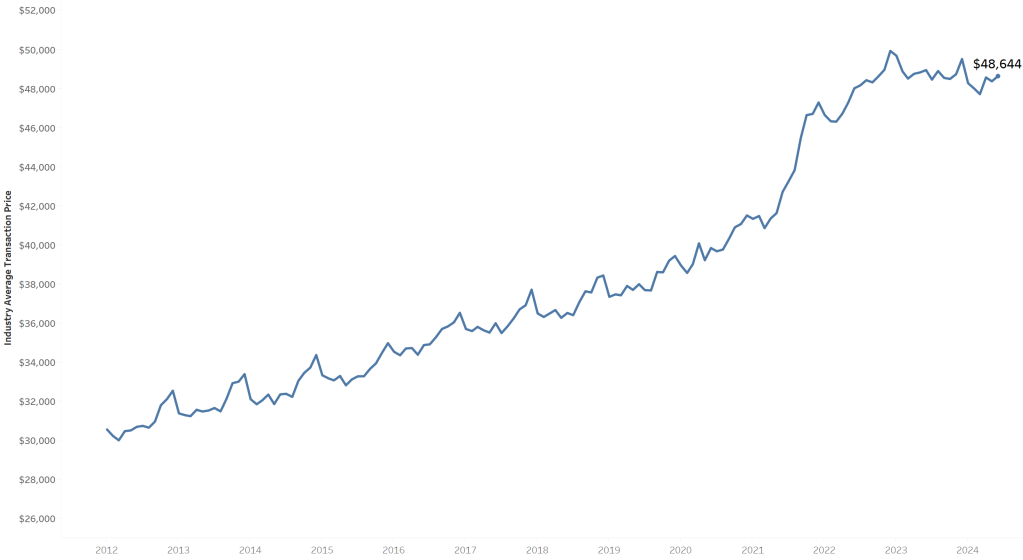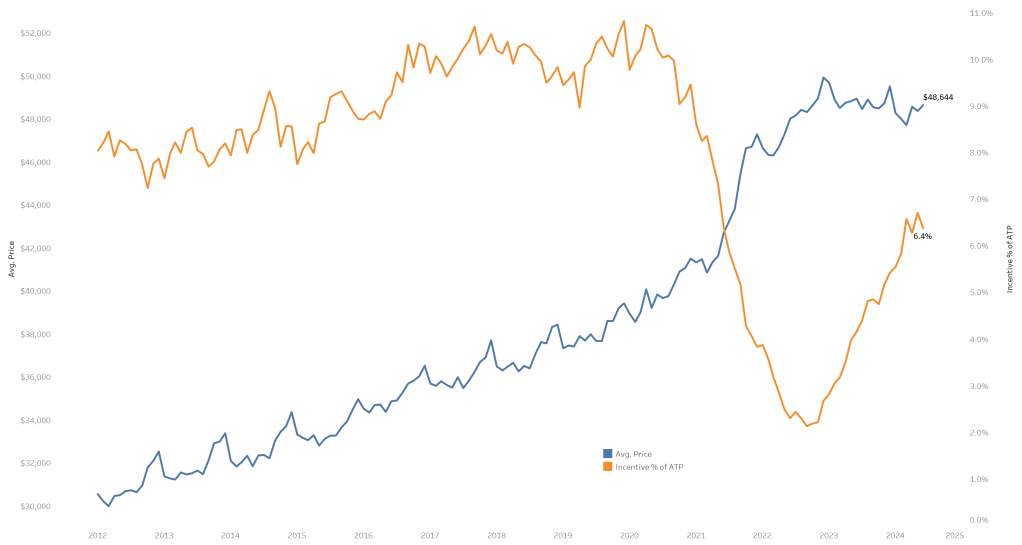Data Point
New-Vehicle Prices Hold Steady in June, as Price Pressure Continues to Steer Market, According to Kelley Blue Book Estimates
Wednesday July 10, 2024
Article Highlights
- New-vehicle transaction prices held steady in June, climbing less than 1% from May and trending lower year over year.
- In June, incentives declined month over month despite generally higher inventory levels. The average incentive package was 6.4% of ATP, down from 6.7% in May.
- Tesla prices continue to trend higher, driving an increase in the overall EV segment; the Tesla Cybertruck is America’s best-selling vehicle priced over $100,000.
ATLANTA, July 10, 2024 – New-vehicle prices remain steady, as average transaction prices in June were mostly unchanged from May and one year ago. In June, according to data released today by Kelley Blue Book, the average transaction price (ATP) for a new vehicle in the U.S. was $48,644. The June ATP was higher by $266 (0.6%) from the revised May ATP and lower by $307 (0.6%) compared to June 2023. In June, the new-vehicle ATP was lower year over year for the ninth straight month.
NEW-VEHICLE AVERAGE TRANSACTION PRICE

Incentives – measured as a percent of ATP – were lower in June than in May. The average new-vehicle incentive package, which includes discounts and rebates, fell to 6.4% of ATP ($3,102) last month, down from 6.7% in May but higher than one year ago when incentives were 4.2% of ATP ($2,036). Many top sellers pulled back on incentives in June despite higher inventory levels. Land Rover, Porsche and Toyota were among the brands with the lowest incentives in June. At the higher end, Audi, Infiniti, Nissan and VW were among the most generous.
INDUSTRY AVERAGE TRANSACTION PRICE VERSUS INDUSTRY AVERAGE INCENTIVE SPEND AS % OF ATP
“As we head into the back half of the year, we are seeing that automakers are showing real discipline on pricing,” said Cox Automotive Executive Analyst Erin Keating. “Even brands holding onto more days’ supply, like many Stellantis brands, are keeping incentive spend in check. In June, Jeep increased to 6.3% – still below industry average – from 5.3%, and Ram actually declined to 5.5% from 6.3%. There appears to be a real effort to hold the line out there.”
Affordability and Credit Availability Matters
While the average transaction price for a new vehicle in the U.S. hovers near $49,000, affordability matters. In June, 40% of vehicles transacted for below $40,000, and 26% transacted or between $30-and-$40,000. According to Kelley Blue Book estimates, among the top ten best-selling vehicles in June, half carried ATPs below $40,000 – the Toyota RAV4, Honda CR-V, Toyota Camry, Honda Civic and Chevrolet Trax.
“Anytime you speak in averages, there will be factors that can skew the big picture,” added Keating. “We know that nearly half of the market sells for well below average, so the elevated ATP doesn’t mean there are no affordable vehicles for customers. At the same time, it is often the monthly payment that really matters, so we can’t ignore the impact interest rates are having on people’s ability to pay.”
In June, auto credit availability decreased across all lender categories, as reported by the Dealertrack Credit Availability Index. Consumers faced more restricted credit access both month over month and year over year, with approval rates dropping and new-vehicle loans becoming particularly harder to obtain. Additionally, consumers are now paying a higher premium for auto loans compared to the bond market, potentially affecting affordability.
Still, the best-selling vehicle in the U.S. continues to be a full-size pickup from Ford, a vehicle with a full-size price. In June, the Ford F-Series ATP was $67,443, up 30% from five years ago. More than 65,000 full-size Fords were sold in June. High-volume, full-size pickup trucks from Chevrolet, GMC and Ram – all among the top ten best-selling products in the U.S. – help drive average prices higher, as the Kelley Blue Book data on average transaction price is sales-weighted.
EV Prices Trend Higher After Hitting Bottom in March
In June, the average price paid for a new electric vehicle (EV) was $56,371, an increase of 0.9% compared to May. EV prices in June were lower by 2.5% versus June 2023.
New EV prices have been trending higher since the spring, when transaction prices fell to $53,235 in March. In large part, the higher prices for EVs are being driven by market leader Tesla, which has seen prices increase 13% since January. While prices for the popular Model Y and Model 3 held relatively steady month over month in June – although both have increased significantly since January – the new Cybertruck is likely one reason Tesla ATPs have increased. In June, the Cybertruck was the best-selling vehicle priced over $100,000 – average transaction price: $112,696 – with more than 3,200 units sold.
Despite prices trending higher, EV sales in Q2 improved versus Q1 and were higher year over year by more than 11%. In fact, 330,000 EVs were sold in Q2 in the U.S., a record quarter for electric-vehicle volume.

